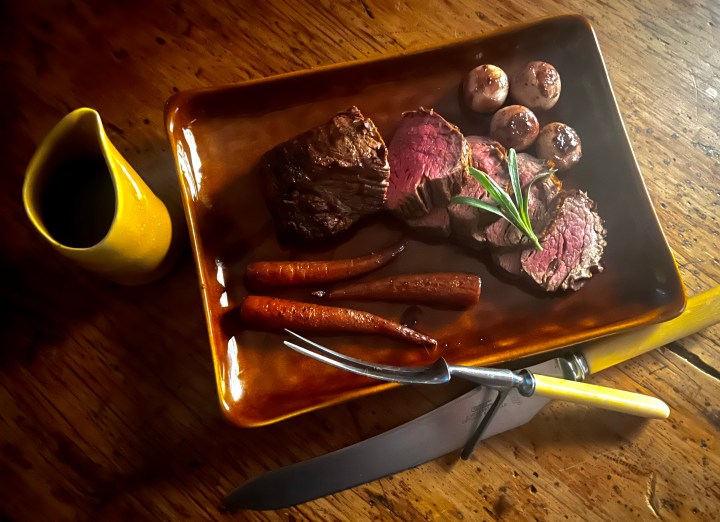FRENCH CLASSIC
Throwback Thursday: Chateaubriand

Chateaubriand, created for but not by the French aristocrat Francois-René Vicomte de Chateaubriand, is not so much a cut of meat as a recipe for it.
In the old-style dining rooms and restaurants, the kind which would have a maitre d’hotel and waiters dressed more smartly than some of the guests, Chateaubriand was the kind of dish that would be wheeled to your table on a trolley to be finished with haughty efficiency by a snooty waiter after brushing the crumbs off the white damask while emitting an almost imperceptible sigh.
Chateaubriand is traditionally served for two, and the waiter, often the maitre’d himself, who had a habit of awarding himself the loftier tasks in the dining room, would carefully share it out and dress it with red wine sauce on your plates. The silver serving dish with its compartments for the various vegetables of the day would be brought out and the carrots and creamed spinach served like a well-heeled robber dividing the spoils.
It is thought to have been invented by a chef called Montmireil around 1822, for the French aristocrat François-René Vicomte de Chateaubriand, a notable writer and historian and very clever man by all accounts, including his own. Wikipedia confides that Chateaubriand “saw himself as the greatest lover, the greatest writer, and the greatest philosopher of his age” and that he “dominated the literary scene in France in the first half of the nineteenth century”.
Despite all that, the name is far better known today for the steak his chef invented for his pleasure. His daddy had been a marine captain and slave trader and became very rich as a result, so the young François-René, while growing up in a splendid cheateau in Brittany, knew nothing but wealth and fine things. Which I suppose is fitting, the dish being a fine thing indeed and not cheap either.
Those who, today, are emphatic that a chateaubriand is a very specific cut of beef are not correct. As a “cut” it has come to mean, by and large, the thicker part of a beef fillet, trimmed. But it is a recipe, not a cut as such. But some earlier accounts of it say that it was originally cut not from the fillet but the sirloin, another prized cut but cheaper than the fillet. Horrifically (for me at any rate), it is said to have been cooked between two cheaper cuts of steak which were then discarded, to protect the integrity of the meat one imagines. I’m glad that tradition did not hold; it is heat and contact with the pan or grill that give meat its char which in turn gives it its flavour. So the char and flavour would have been on the cheaper beef that was thrown away. I’d put money on it going home with the kitchen staff and being relished in their urban hovels.
Our habit today of presuming the chateaubriand to be that centre cut of the beef tenderloin is traced back to Auguste Escoffier, who named it thus, says its Wikipedia entry.
Today, it is widely expected to be seared and then roasted until medium rare, and served with a red wine jus. The other tradition of it also being served with chateau potatoes (oval potato balls which are parboiled and then braised in butter until crisp and golden) is not as common, or as expected, as it once was.
The sauce is generally expected to include tarragon and shallots and to be generous with the butter. I used red onion, for the usual reason of shallots not being available, but use them if you can source some. Many recipes include lemon juice but I left it out as I felt there was plenty of acidity from the red wine, which I think should be used generously. I also used garlic, which is not really traditional. There’s beef stock in my recipe too, for depth of flavour and impact, and I enriched it with an additional knob of butter at the end in the good old Keith Floyd tradition.
Ingredients
1 x 900 g centre cut of beef fillet
2 Tbsp butter
2 Tbsp olive oil
2 small red onions, finely chopped
2 garlic cloves, finely chopped
1 cup/ 250 ml good red wine
1 cup/ 250 ml beef stock
2 Tbsp fresh French tarragon leaves, chopped
Fresh tarragon for garnish
Salt
Black pepper
A knob of butter
Method
Trim the beef of extraneous fat and tissue and make sure it’s at room temperature.
Preheat the oven to 200℃.
Season the meat with coarse sea (kosher) salt and black pepper.
In a skillet or heavy iron pan, brown all sides really well in butter and olive oil.
Transfer to the oven for 15 to 20 minutes. Remove. Cover it loosely in a foil tent and leave it to rest.
Sauté onion and garlic in the same pan, scraping up the bits from the bottom. Add red wine and reduce. Add beef stock and reduce. Enrich with butter.
Stir in the chopped tarragon, taste for seasoning and adjust if needed. Bring out your best plates or platters to show it off to its best advantage. DM/TGIFood
Tony Jackman is Galliova Food Champion 2021. His book, foodSTUFF, is available in the DM Shop. Buy it here.
Mervyn Gers Ceramics supplies dinnerware for the styling of some TGIFood shoots. Mervyn Gers has expanded the base for his ceramic ware to New Zealand and Australia, through the Sydney-based iKhaya Collections. For more information, click here.





 Become an Insider
Become an Insider
Comments - Please login in order to comment.